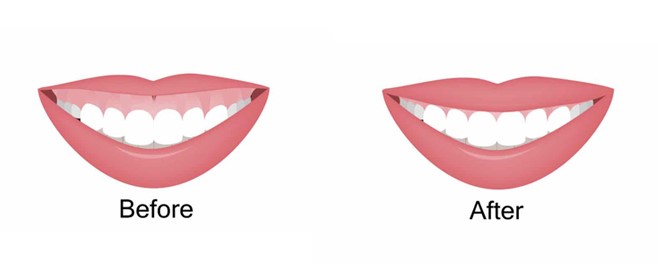By Dr. Michael Handler
What is a Gummy Smile?
A gummy smile (Excessive Gingival Display) occurs when a larger than proportionate amount of gum tissue shows above the upper teeth when smiling. The perception of a gummy smile can be determined visually, but has also been described as occurring when there is more than 4 millimetres of gum tissue being exposed.
If you believe you have a gummy smile, it’s best to visit your dentist who can take x-rays and do a few tests to determine the cause of your gummy smile before deciding which type of treatment will be most suitable.

What causes a Gummy Smile?
- Teeth may be too small, which can be genetic or as a result of use. If teeth become worn down over time, the top teeth will attempt to maintain the correct bite by erupting down further, or for some people, the teeth may also have erupted further down naturally.
- Gums can grow too far over the teeth as a result of mouth breathing, some medications or inadequate dental hygiene.
- Gums can grow too far over the teeth as a result of mouth breathing, some medications or inadequate dental hygiene.
- The most common cause of a gummy smile is that the upper jaw is longer than it should be, in relation to the size of the face and lip tissue available to cover the gums, so there is an excessive amount of gum tissue visible on both sides of the teeth.
Gummy Smile Treatment
Although a gummy smile may not be indicative of any underlying issues, many people with a gummy smile feel self-conscious about the aesthetic appearance of their smile. Fortunately, there are several different treatment options available to fix a gummy smile and create a more balanced ratio of gums to teeth.
These options include a gingivectomy, crown lengthening, orthognathic surgery, lip repositioning, and botox. Figuring out which option is right for you largely depends on the root cause of your gummy smile.
- Gingivectomy: This procedure reshapes your excess gums to expose the natural shape of your teeth. It creates a nice balance between the gums, which are shortened, and the teeth, which are lengthened.
- Lip repositioning: This procedure addresses a gummy smile caused by either a short or hypermobile upper lip that exposes too much gum when you smile. It is a simple and safe procedure that restricts the pull of the muscles in your upper lip.
- Crown lengthening: In this procedure, your excess gum tissue and the underlying bone are cut and reshaped to expose the full length of your teeth.
- Orthognathic surgery: This is a more intensive procedure that tackles a gummy smile that is caused by an excessively long upper jaw (as compared to the bottom part of the skull). During the procedure, the upper jaw is recontoured to the proper shape and then secured into a new position that reduces the amount of gumminess in your smile.
- Botox: This is the least invasive and most short-term way of dealing with a gummy smile. Botox works by temporarily paralyzing some of the muscles so that they don’t drastically raise your upper lip. While this is a cheaper and faster fix than surgery, the results typically only last a few months — Botox needs to be repeated frequently for any long-term results. However, if you are considering eventual lip repositioning for a gummy smile, Botox can be a great way to test out what you will look like before undergoing surgery.
For more information on gummy smiles and its treatment, please call our dentists in Scarborough at 416-267-4661, or click here to book online.
-
Welcome
-
Blog
-
How to Fix a Gummy Smile
